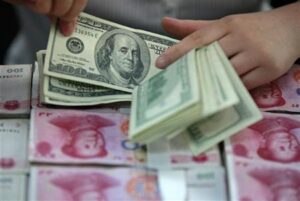>>REAL-TIME UPDATES IN THE WIRE. CLICK HERE<<<
China’s central bank will ask financial institutions to hold more foreign exchange in reserve, a move that could help tighten foreign currency liquidity and curb a sharp rally in the yuan.
The People’s Bank of China (PBOC) said on Monday that it will raise the foreign exchange reserve requirement ratio for financial institutions to 7 per cent from 5 per cent, effective from June 15. The increase will make it more expensive for banks to hold dollars.
It marks the first adjustment of the ratio in 14 years. The previous change occurred in May 2007, when the ratio was raised to 5 per cent from 4 per cent.
“The aim is to tighten foreign currency liquidity, raise foreign currency interest rates, so as to ease the yuan’s appreciationary pressure,” said Shuang Ding, head of Greater China economic research at Standard Chartered.
Financial institutions will have to hold more foreign-currency deposits as reserve requirements at the central bank, said Lian Ping, head of Zhixin Investment Research Institute.
Banks in China held about $1 trillion in foreign currency deposits as of the end of April and the PBOC’s move will freeze about $20 billion dollar liquidity in the domestic market, said Guan Tao, global chief economist at the BOC International and a former senior official at China’s State Administration of Foreign Exchanges.
Guan said the PBOC’s use of the FX reserve requirement ratio, a tool little used in the past “shows that the PBOC still has many tools in its toolkit, and it has plenty of freedom to choose. In the future if speculative trading appears in the foreign exchange market, it has a steady supply of macro-prudential tools at its disposal.”
“In the past, when the PBOC adjusted to the reserve requirement ratio on yuan deposits, the size was usually 0.5 percentage points. The 2 percentage point raise announced on Monday is obviously bigger than the central bank’s usual move,” said Guan.
“The central bank is sending a message that it will not let the yuan appreciate too fast and it’s prepared to take action when necessary,” said Guan. “The PBOC will strike hard if it does decide to intervene.”
The PBOC move came after the yuan hit a three-year high against the US dollar. On Monday, the central bank lifted the yuan’s daily fixing to its strongest level since May 17, 2018.
The firmer fixing also pushed the trade-weighted yuan basket index up to 98.22, its highest since March 29, 2016. Market players have widely viewed the 98 mark as the basket’s ceiling, as levels above that are seen to mean a loss of competitive advantage for China against its trading partners.
The yuan might have overshot, and its rapid gains would be unsustainable and could hurt Chinese exporters, Sheng Songcheng, a former central bank official, told the Xinhua News Agency in an interview on Sunday.
Earlier, a slew of current and former central bank officials have also cautioned against one-way bets on the yuan and pledged crackdown on currency manipulation.
A commentary from Financial News, a PBOC-run publication, said on Sunday that the yuan is under pressure to depreciate amid factors including exit of monetary easing by the US Federal Reserve, economic recovery in the US, improvement in pandemic control around the globe, etc.
Peng Wensheng, chief economist at the China International Capital Corporation, said that in the future there will be more factors that could reverse the yuan’s sharp strengthening and China can’t use the yuan’s exchange rate as a policy tool.

